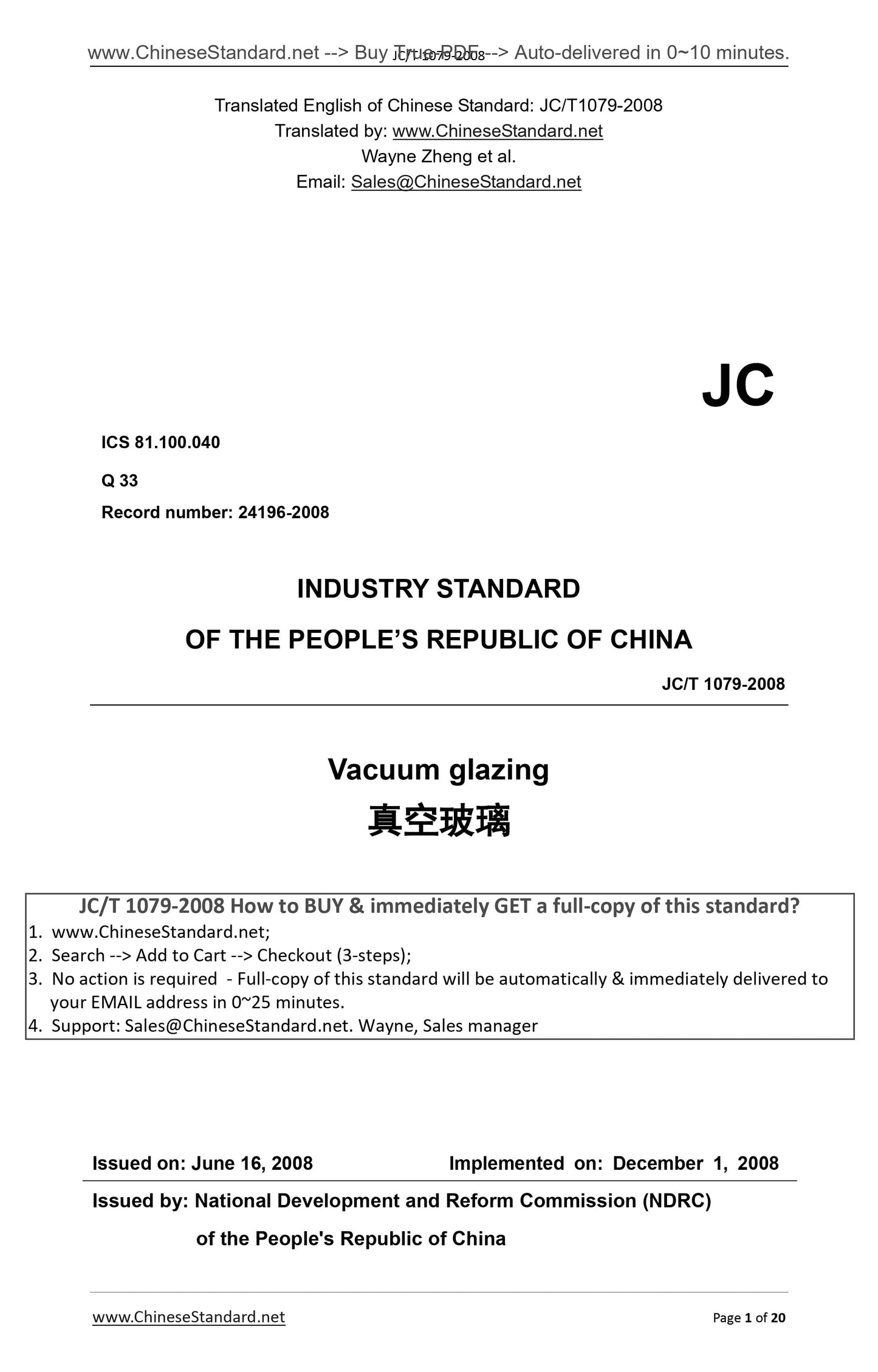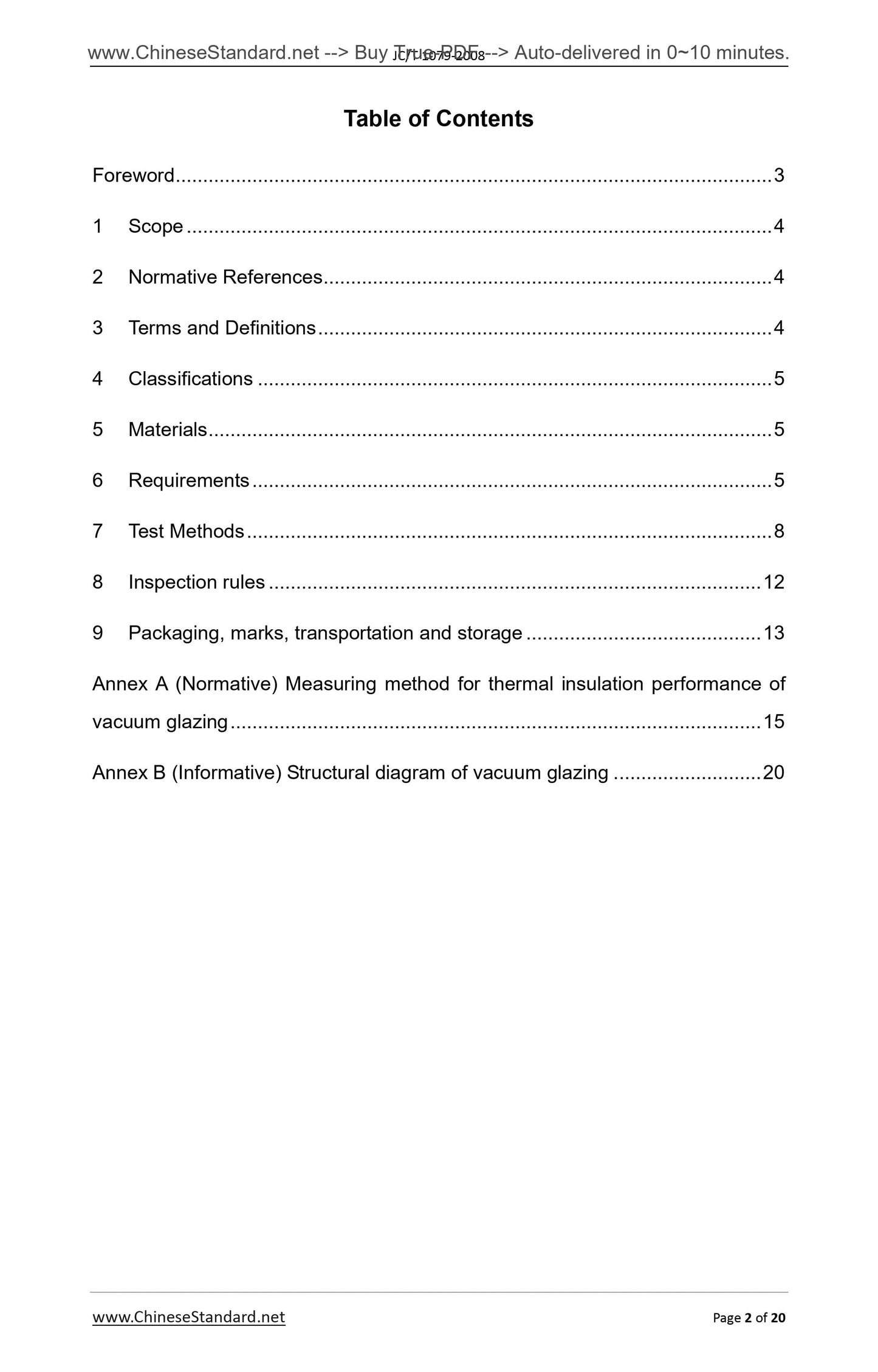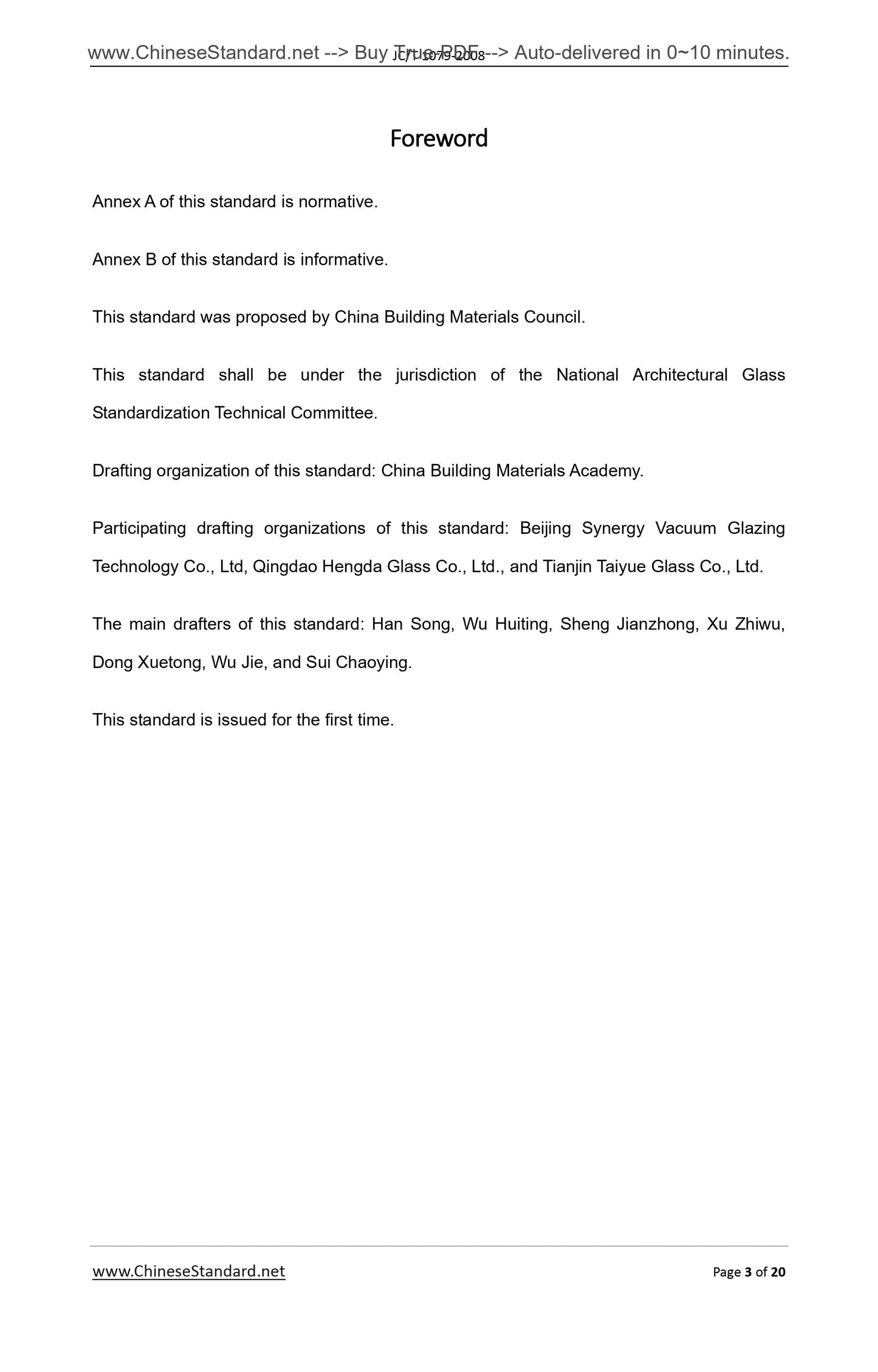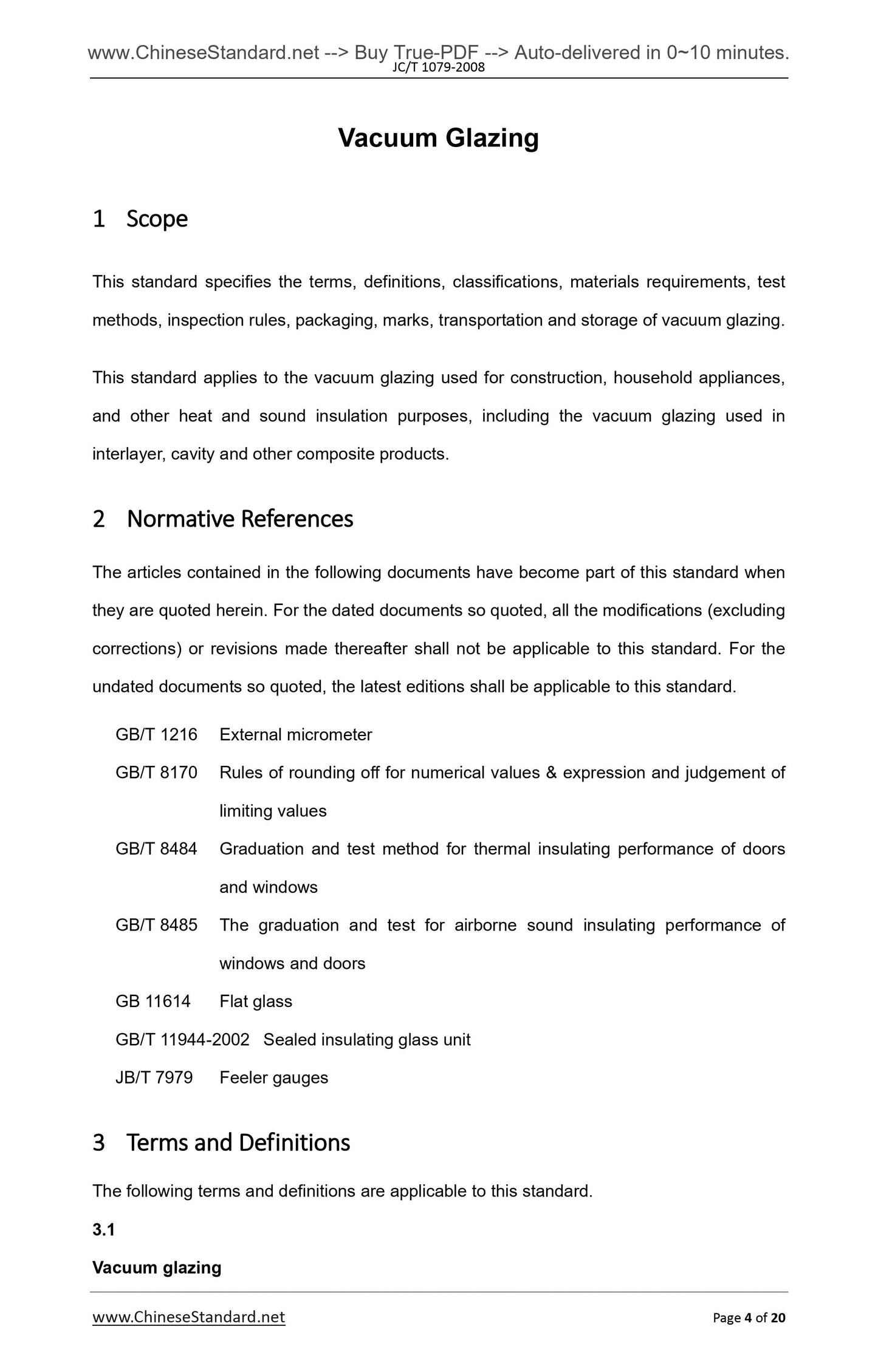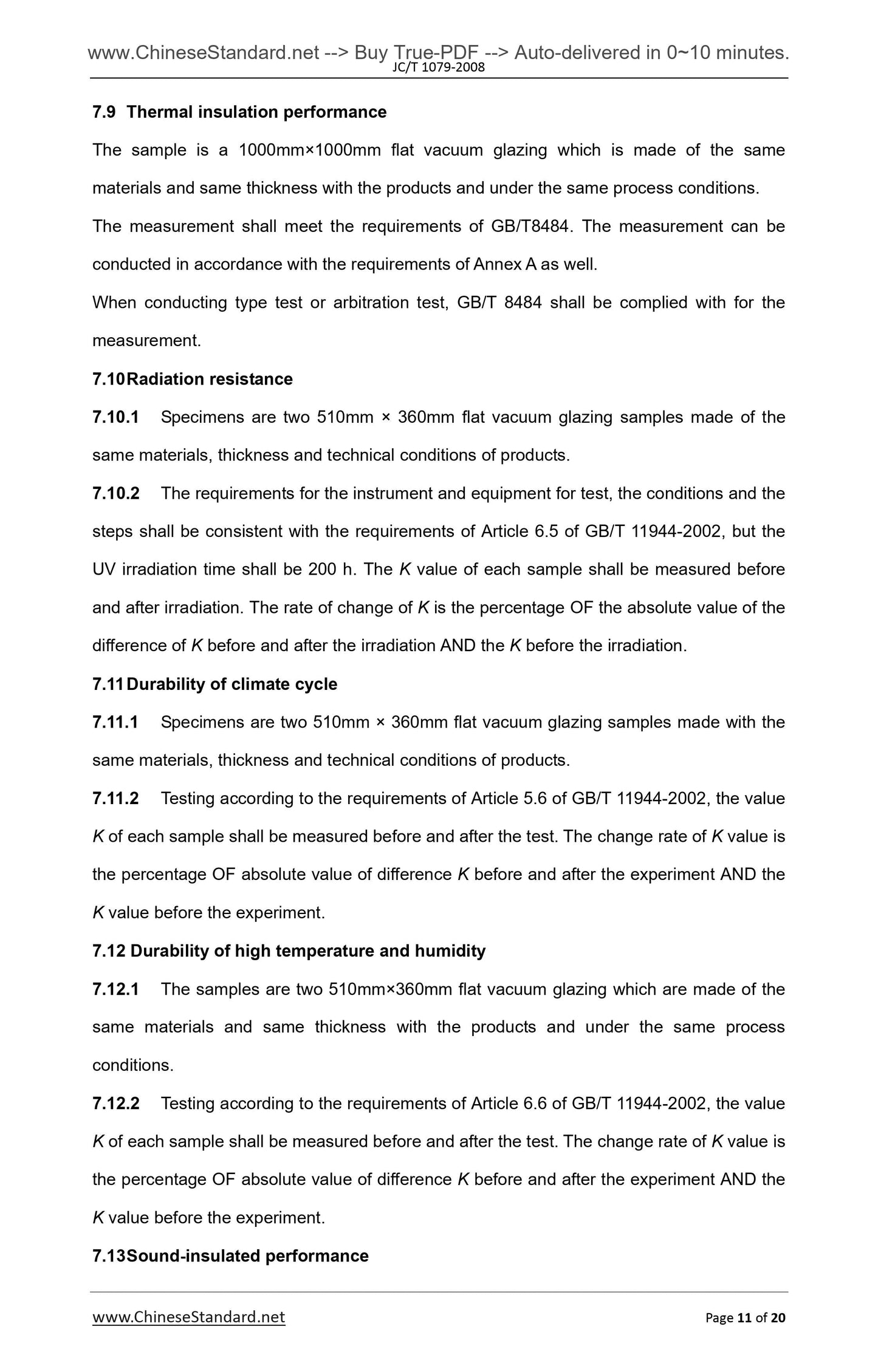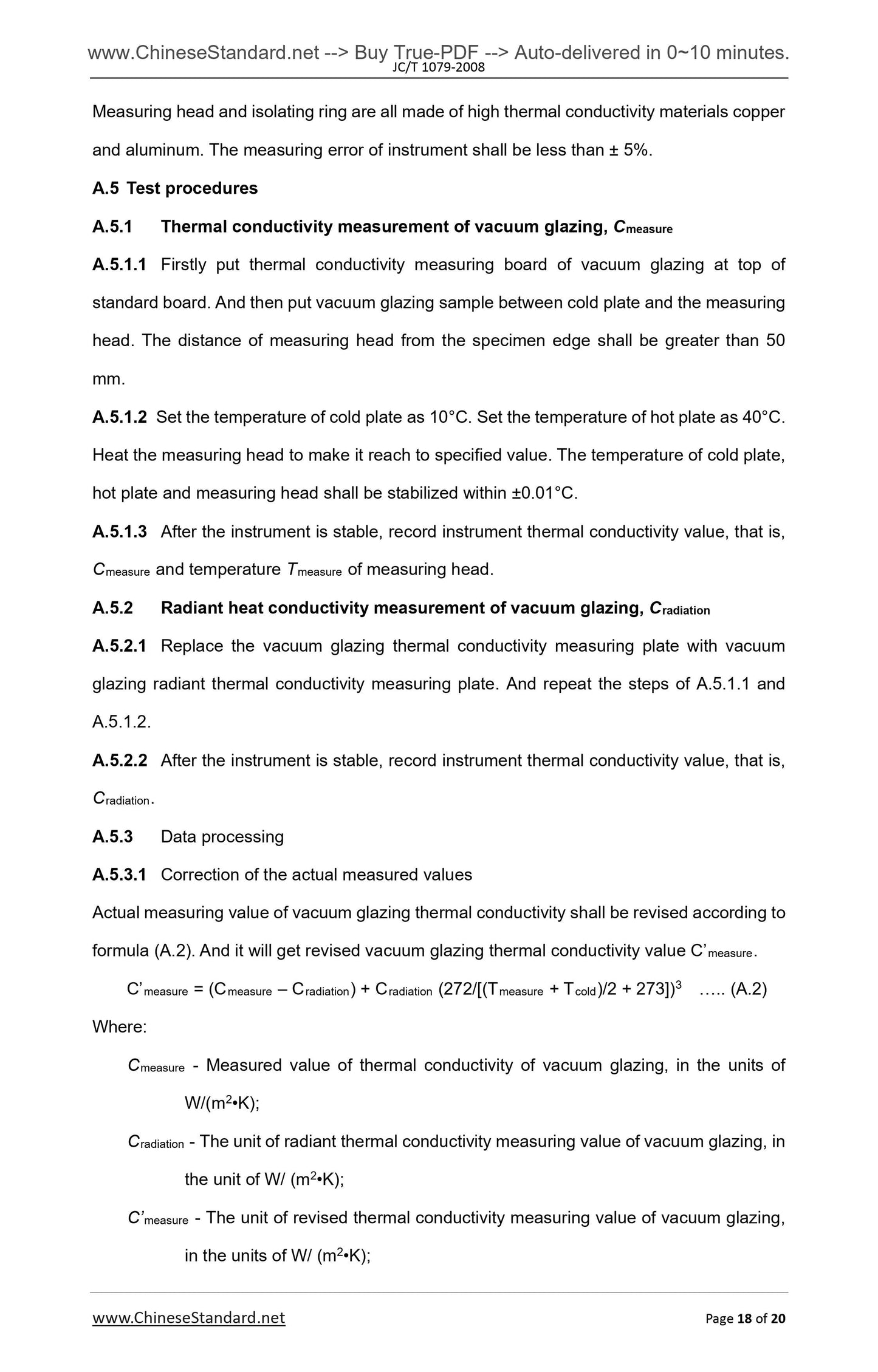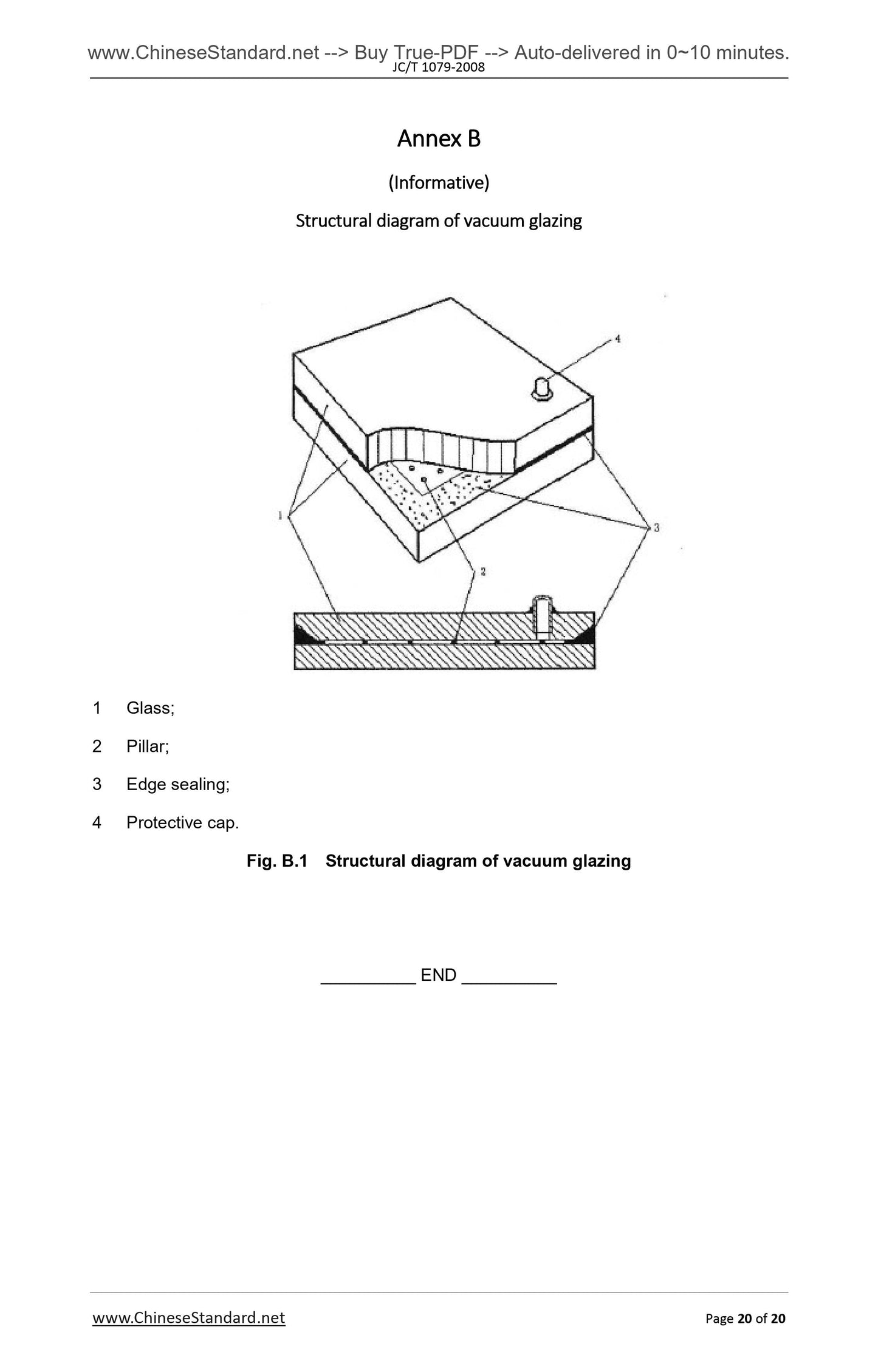1
/
of
7
PayPal, credit cards. Download editable-PDF and invoice in 1 second!
JC/T 1079-2008 English PDF (JC/T1079-2008)
JC/T 1079-2008 English PDF (JC/T1079-2008)
Regular price
$150.00 USD
Regular price
Sale price
$150.00 USD
Unit price
/
per
Shipping calculated at checkout.
Couldn't load pickup availability
Delivery: 3 seconds. Download true-PDF + Invoice.
Get QUOTATION in 1-minute: Click JC/T 1079-2008
Historical versions: JC/T 1079-2008
Preview True-PDF (Reload/Scroll if blank)
JC/T 1079-2008: Vacuum glazing
JC/T 1079-2008
JC
ICS 81.100.040
Q 33
Record number. 24196-2008
INDUSTRY STANDARD
OF THE PEOPLE’S REPUBLIC OF CHINA
Vacuum glazing
真空玻璃
ISSUED ON. JUNE 16, 2008
IMPLEMENTED ON. DECEMBER 1, 2008
Issued by. National Development and Reform Commission (NDRC)
of the People's Republic of China
Table of Contents
Foreword ... 3
1 Scope ... 4
2 Normative References ... 4
3 Terms and Definitions ... 4
4 Classifications ... 5
5 Materials ... 5
6 Requirements ... 5
7 Test Methods ... 8
8 Inspection rules ... 12
9 Packaging, marks, transportation and storage ... 13
Annex A (Normative) Measuring method for thermal insulation performance of
vacuum glazing ... 15
Annex B (Informative) Structural diagram of vacuum glazing ... 20
Foreword
Annex A of this standard is normative.
Annex B of this standard is informative.
This standard was proposed by China Building Materials Council.
This standard shall be under the jurisdiction of the National Architectural Glass
Standardization Technical Committee.
Drafting organization of this standard. China Building Materials Academy.
Participating drafting organizations of this standard. Beijing Synergy Vacuum Glazing
Technology Co., Ltd, Qingdao Hengda Glass Co., Ltd., and Tianjin Taiyue Glass Co., Ltd.
The main drafters of this standard. Han Song, Wu Huiting, Sheng Jianzhong, Xu Zhiwu,
Dong Xuetong, Wu Jie, and Sui Chaoying.
This standard is issued for the first time.
Vacuum Glazing
1 Scope
This standard specifies the terms, definitions, classifications, materials requirements, test
methods, inspection rules, packaging, marks, transportation and storage of vacuum glazing.
This standard applies to the vacuum glazing used for construction, household appliances,
and other heat and sound insulation purposes, including the vacuum glazing used in
interlayer, cavity and other composite products.
2 Normative References
The articles contained in the following documents have become part of this standard when
they are quoted herein. For the dated documents so quoted, all the modifications (excluding
corrections) or revisions made thereafter shall not be applicable to this standard. For the
undated documents so quoted, the latest editions shall be applicable to this standard.
GB/T 1216 External micrometer
GB/T 8170 Rules of rounding off for numerical values and expression and judgement of
limiting values
GB/T 8484 Graduation and test method for thermal insulating performance of doors
and windows
GB/T 8485 The graduation and test for airborne sound insulating performance of
windows and doors
GB 11614 Flat glass
GB/T 11944-2002 Sealed insulating glass unit
JB/T 7979 Feeler gauges
3 Terms and Definitions
The following terms and definitions are applicable to this standard.
3.1
Vacuum glazing
7.9 Thermal insulation performance
The sample is a 1000mm×1000mm flat vacuum glazing which is made of the same
materials and same thickness with the products and under the same process conditions.
The measurement shall meet the requirements of GB/T8484. The measurement can be
conducted in accordance with the requirements of Annex A as well.
When conducting type test or arbitration test, GB/T 8484 shall be complied with for the
measurement.
7.10 Radiation resistance
7.10.1 Specimens are two 510mm × 360mm flat vacuum glazing samples made of the
same materials, thickness and technical conditions of products.
7.10.2 The requirements for the instrument and equipment for test, the conditions and the
steps shall be consistent with the requirements of Article 6.5 of GB/T 11944-2002, but the
UV irradiation time shall be 200 h. The K value of each sample shall be measured before
and after irradiation. The rate of change of K is the percentage OF the absolute value of the
difference of K before and after the irradiation AND the K before the irradiation.
7.11 Durability of climate cycle
7.11.1 Specimens are two 510mm × 360mm flat vacuum glazing samples made with the
same materials, thickness and technical conditions of products.
7.11.2 Testing according to the requirements of Article 5.6 of GB/T 11944-2002, the value
K of each sample shall be measured before and after the test. The change rate of K value is
the percentage OF absolute value of difference K before and after the experiment AND the
K value before the experiment.
7.12 Durability of high temperature and humidity
7.12.1 The samples are two 510mm×360mm flat vacuum glazing which are made of the
same materials and same thickness with the products and under the same process
conditions.
7.12.2 Testing according to the requirements of Article 6.6 of GB/T 11944-2002, the value
K of each sample shall be measured before and after the test. The change rate of K value is
the percentage OF absolute value of difference K before and after the experiment AND the
K value before the experiment.
7.13 Sound-insulated performance
Measuring head and isolating ring are all made of high thermal conductivity materials copper
and aluminum. The measuring error of instrument shall be less than ± 5%.
A.5 Test procedures
A.5.1 Thermal conductivity measurement of vacuum glazing, Cmeasure
A.5.1.1 Firstly put thermal conductivity measuring board of vacuum glazing at top of
standard board. And then put vacuum glazing sample between cold plate and the measuring
head. The distance of measuring head from the specimen edge shall be greater than 50
mm.
A.5.1.2 Set the temperature of cold plate as 10°C. Set the temperature of hot plate as 40°C.
Heat the measuring head to make it reach to specified value. The temperature of cold plate,
hot plate and measuring head shall be stabilized within ±0.01°C.
A.5.1.3 After the instrument is stable, record instrument thermal conductivity value, that is,
Cmeasure and temperature Tmeasure of measuring head.
A.5.2 Radiant heat conductivity measurement of vacuum glazing, Cradiation
A.5.2.1 Replace the vacuum glazing thermal conductivity measuring plate with vacuum
glazing radiant thermal conductivity measuring plate. And repeat the steps of A.5.1.1 and
A.5.1.2.
A.5.2.2 After the instrument is stable, record instrument thermal conductivity value, that is,
Cradiation.
A.5.3 Data processing
A.5.3.1 Correction of the actual measured values
Actual measuring value of vacuum glazing thermal conductivity shall be revised according to
formula (A.2). And it will get revised vacuum glazing thermal conductivity value C’measure.
C’measure = (Cmeasure – Cradiation) + Cradiation (272/[(Tmeasure + Tcold)/2 + 273])3 ... (A.2)
Where.
Cmeasure - Measured value of thermal conductivity of vacuum glazing, in the units of
W/(m2•K);
Cradiation - The unit of radiant thermal conductivity measuring value of vacuum glazing, in
the unit of W/ (m2•K);
C’measure - The unit of revised thermal conductivity measuring value of vacuum glazing,
in the units of W/ (m2•K);
Annex B
(Informative)
Structural diagram of vacuum glazing
1 Glass;
2 Pillar;
3 Edge sealing;
4 Protective cap.
Fig. B.1 Structural diagram of vacuum glazing
Get QUOTATION in 1-minute: Click JC/T 1079-2008
Historical versions: JC/T 1079-2008
Preview True-PDF (Reload/Scroll if blank)
JC/T 1079-2008: Vacuum glazing
JC/T 1079-2008
JC
ICS 81.100.040
Q 33
Record number. 24196-2008
INDUSTRY STANDARD
OF THE PEOPLE’S REPUBLIC OF CHINA
Vacuum glazing
真空玻璃
ISSUED ON. JUNE 16, 2008
IMPLEMENTED ON. DECEMBER 1, 2008
Issued by. National Development and Reform Commission (NDRC)
of the People's Republic of China
Table of Contents
Foreword ... 3
1 Scope ... 4
2 Normative References ... 4
3 Terms and Definitions ... 4
4 Classifications ... 5
5 Materials ... 5
6 Requirements ... 5
7 Test Methods ... 8
8 Inspection rules ... 12
9 Packaging, marks, transportation and storage ... 13
Annex A (Normative) Measuring method for thermal insulation performance of
vacuum glazing ... 15
Annex B (Informative) Structural diagram of vacuum glazing ... 20
Foreword
Annex A of this standard is normative.
Annex B of this standard is informative.
This standard was proposed by China Building Materials Council.
This standard shall be under the jurisdiction of the National Architectural Glass
Standardization Technical Committee.
Drafting organization of this standard. China Building Materials Academy.
Participating drafting organizations of this standard. Beijing Synergy Vacuum Glazing
Technology Co., Ltd, Qingdao Hengda Glass Co., Ltd., and Tianjin Taiyue Glass Co., Ltd.
The main drafters of this standard. Han Song, Wu Huiting, Sheng Jianzhong, Xu Zhiwu,
Dong Xuetong, Wu Jie, and Sui Chaoying.
This standard is issued for the first time.
Vacuum Glazing
1 Scope
This standard specifies the terms, definitions, classifications, materials requirements, test
methods, inspection rules, packaging, marks, transportation and storage of vacuum glazing.
This standard applies to the vacuum glazing used for construction, household appliances,
and other heat and sound insulation purposes, including the vacuum glazing used in
interlayer, cavity and other composite products.
2 Normative References
The articles contained in the following documents have become part of this standard when
they are quoted herein. For the dated documents so quoted, all the modifications (excluding
corrections) or revisions made thereafter shall not be applicable to this standard. For the
undated documents so quoted, the latest editions shall be applicable to this standard.
GB/T 1216 External micrometer
GB/T 8170 Rules of rounding off for numerical values and expression and judgement of
limiting values
GB/T 8484 Graduation and test method for thermal insulating performance of doors
and windows
GB/T 8485 The graduation and test for airborne sound insulating performance of
windows and doors
GB 11614 Flat glass
GB/T 11944-2002 Sealed insulating glass unit
JB/T 7979 Feeler gauges
3 Terms and Definitions
The following terms and definitions are applicable to this standard.
3.1
Vacuum glazing
7.9 Thermal insulation performance
The sample is a 1000mm×1000mm flat vacuum glazing which is made of the same
materials and same thickness with the products and under the same process conditions.
The measurement shall meet the requirements of GB/T8484. The measurement can be
conducted in accordance with the requirements of Annex A as well.
When conducting type test or arbitration test, GB/T 8484 shall be complied with for the
measurement.
7.10 Radiation resistance
7.10.1 Specimens are two 510mm × 360mm flat vacuum glazing samples made of the
same materials, thickness and technical conditions of products.
7.10.2 The requirements for the instrument and equipment for test, the conditions and the
steps shall be consistent with the requirements of Article 6.5 of GB/T 11944-2002, but the
UV irradiation time shall be 200 h. The K value of each sample shall be measured before
and after irradiation. The rate of change of K is the percentage OF the absolute value of the
difference of K before and after the irradiation AND the K before the irradiation.
7.11 Durability of climate cycle
7.11.1 Specimens are two 510mm × 360mm flat vacuum glazing samples made with the
same materials, thickness and technical conditions of products.
7.11.2 Testing according to the requirements of Article 5.6 of GB/T 11944-2002, the value
K of each sample shall be measured before and after the test. The change rate of K value is
the percentage OF absolute value of difference K before and after the experiment AND the
K value before the experiment.
7.12 Durability of high temperature and humidity
7.12.1 The samples are two 510mm×360mm flat vacuum glazing which are made of the
same materials and same thickness with the products and under the same process
conditions.
7.12.2 Testing according to the requirements of Article 6.6 of GB/T 11944-2002, the value
K of each sample shall be measured before and after the test. The change rate of K value is
the percentage OF absolute value of difference K before and after the experiment AND the
K value before the experiment.
7.13 Sound-insulated performance
Measuring head and isolating ring are all made of high thermal conductivity materials copper
and aluminum. The measuring error of instrument shall be less than ± 5%.
A.5 Test procedures
A.5.1 Thermal conductivity measurement of vacuum glazing, Cmeasure
A.5.1.1 Firstly put thermal conductivity measuring board of vacuum glazing at top of
standard board. And then put vacuum glazing sample between cold plate and the measuring
head. The distance of measuring head from the specimen edge shall be greater than 50
mm.
A.5.1.2 Set the temperature of cold plate as 10°C. Set the temperature of hot plate as 40°C.
Heat the measuring head to make it reach to specified value. The temperature of cold plate,
hot plate and measuring head shall be stabilized within ±0.01°C.
A.5.1.3 After the instrument is stable, record instrument thermal conductivity value, that is,
Cmeasure and temperature Tmeasure of measuring head.
A.5.2 Radiant heat conductivity measurement of vacuum glazing, Cradiation
A.5.2.1 Replace the vacuum glazing thermal conductivity measuring plate with vacuum
glazing radiant thermal conductivity measuring plate. And repeat the steps of A.5.1.1 and
A.5.1.2.
A.5.2.2 After the instrument is stable, record instrument thermal conductivity value, that is,
Cradiation.
A.5.3 Data processing
A.5.3.1 Correction of the actual measured values
Actual measuring value of vacuum glazing thermal conductivity shall be revised according to
formula (A.2). And it will get revised vacuum glazing thermal conductivity value C’measure.
C’measure = (Cmeasure – Cradiation) + Cradiation (272/[(Tmeasure + Tcold)/2 + 273])3 ... (A.2)
Where.
Cmeasure - Measured value of thermal conductivity of vacuum glazing, in the units of
W/(m2•K);
Cradiation - The unit of radiant thermal conductivity measuring value of vacuum glazing, in
the unit of W/ (m2•K);
C’measure - The unit of revised thermal conductivity measuring value of vacuum glazing,
in the units of W/ (m2•K);
Annex B
(Informative)
Structural diagram of vacuum glazing
1 Glass;
2 Pillar;
3 Edge sealing;
4 Protective cap.
Fig. B.1 Structural diagram of vacuum glazing
Share
